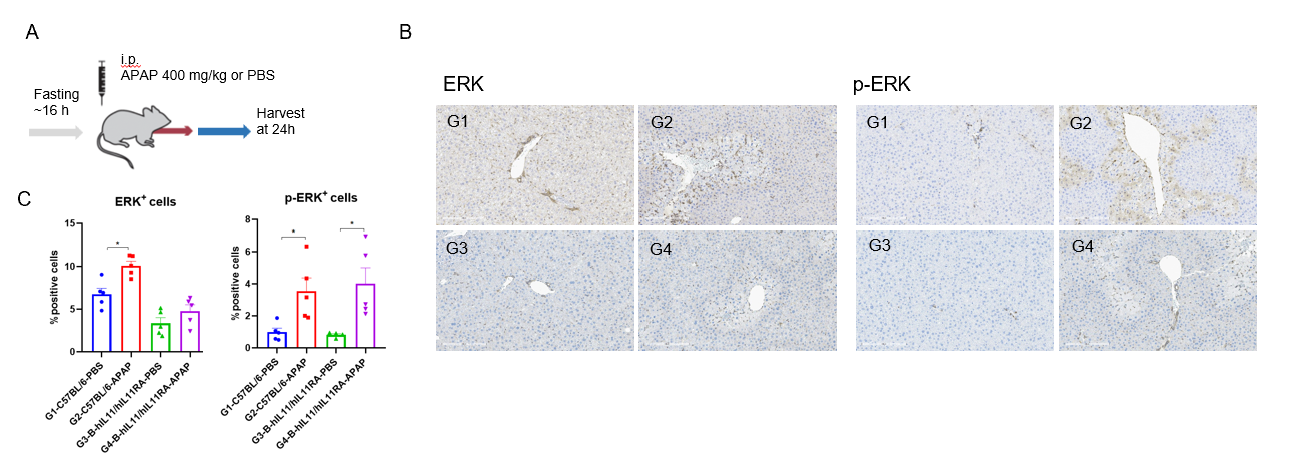Basic Information
-
Targeting strategy

-
Gene targeting strategy for B-hIL11/hIL11RA mice.
The exons 1~5 of mouse Il11 gene that encode the full-length protein were replaced by human IL11 exons 1~5 in B-hIL11/hIL11RA mice. The exons 2-11 of mouse Il11ra gene that encode the extracellular domain were replaced by human IL11RA exons 2-11 in B-hIL11/hIL11RA mice.
-
Protein and mRNA expression analysis

-
Strain specific hIL11 and hIL11RA expression analysis in B-hIL11/hIL11RA mice can refer to the data package of 110079 (B-hIL11 mice) and 110879 (B-hIL11RA mice).
-
Functional analysis

-

Functional analysis in APAP-induced liver damage in male B-hIL11/hIL11RA mice.
(A) Schematic showing the process of APAP-induced liver damage in B-hIL11/hIL11RA mice. B-hIL11/hIL11RA mice (male, 8 weeks, n=5) were fasted overnight and inducted with APAP(400 mg/kg) for 24 h. Liver tissue were collected for functional analysis. (B) Representative IHC images of liver (200 X). (C) Quantification of ERK and p-ERK positive cells from hepatocytes.The IHC results showed that p-ERK increased significantly after APAP induction, and the increase degree was similar to that of wild mice. Values are expressed as mean ± SD. *p<0.05.
-
In vivo efficacy of anti-human IL11RA antibody with HFMCD induced NASH model

-

Anti-human IL11RA antibody inhibited the liver damage in male B-hIL11/hIL11RA mice. (A) Schematic showing the process of treatment in B-hIL11/hIL11RA mice. B-hIL11/hIL11RA mice were first randomly separated to receive STD or HFMCD diet for 6 weeks (n=8). The anti-hIL11RA antibody(provided by the client) treatment started when the mice were fed different diets for 1 week. The liver tissues were collected for analysis. The markers of liver damage, F4/80+ positive cells (B) and α-SMA+ positive areas (C) were increased in the model group (G2) compared to the STD group (G1), indicating that the NASH mouse model was successfully established with B-hIL11/hIL11RA mice. F4/80+ positive cells (B) and α-SMA+ positive areas (C) were reduced in the anti-human IL11RA antibody-treated male mice group compared to the model group (G2), indicating that anti-human IL11RA antibodies were efficacious in inhibiting liver damage in male B-hIL11/hIL11RA mice. Values are expressed as mean ± SEM. STD, standard diet; HFMCD, high-fat methionine, and choline-deficient diet.


